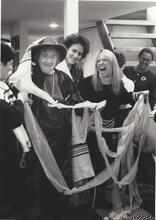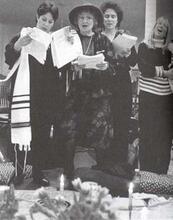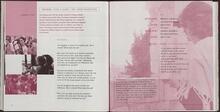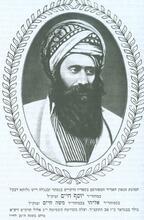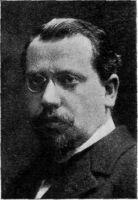Gender Identity In Halakhic Discourse
Jewish law is based on an assumption of gender duality, and fundamental mishnaic texts indicate that this halakhic duality is not conceived symmetrically (as seen through the gendered exemptions of some commandments). Rabbinic halakhic discourse institutes a functional gender duality, anchored in the need of reproduction of the Jewish collective body. As such, it aims to enforce and normalize a congruence between sexed bodies and gendered identities. Furthermore, the semiotics of body surfaces produces other different and seemingly more ambiguous gender possibilities, and rabbinic discourse has widely discussed the halakhic implications of these ambiguities.
Gender Duality
Jewish law is based on a fundamental assumption of gender duality. The Codification of basic Jewish Oral Law; edited and arranged by R. Judah ha-Nasi c. 200 C.E.Mishnah, the earliest text of the rabbinic movement and the foundational text for Jewish law, already reflects self-consciously on the tight gender grid that serves as both the framework and the basis of Jewish law. Hence, as diverse as the various contexts of individual commandments may appear to be, the Mishnah time and again attempts to order and categorize them in a more systematic way according to its dual gender grid. Mishnah Suspected adulteressSotah 3:8 asks the question most directly: “What is the difference between a man and a woman?” and answers it with an eclectic list of The legal corpus of Jewish laws and observances as prescribed in the Torah and interpreted by rabbinic authorities, beginning with those of the Mishnah and Talmud.halakhic rulings from a variety of contexts, ranging from commandments concerning leprosy to capital punishment—a list, in short, that reads like a halakhic compendium on the question of gender and law. Another, more abstract approach is taken by Mishnah Kiddushin 1:7, which famously differentiates the commandments along the line of “obligation” and “exemption.” Whether the ordering principle here is time (“time-bound” commandments), parent-child relationship (“commandments incumbent on the father with respect to the son” and vice versa) or the distinction between positive commandments and prohibitions, men are always and women sometimes obligated, whereas only women are sometimes exempt (Alexander, 105). In this mishnaic reflection on gender and law, then, exemption from religious duties is a halakhic category that can apply only to women. Similarly, the list of Mishnah Sotah 3:8 is rhetorically suspended between a positive and a negative pole: “These are the things that apply to a man, but not to a woman.”
These fundamental mishnaic texts indicate that the gender duality of Jewish law is in fact not conceived as a symmetric duality, as least not from the perspective of the rabbis who began to build the halakhic edifice. One of the earliest critical gestures of Jewish feminists in the United States (e.g. Cynthia Ozick, Rachel Adler, Judith Plaskow) has been to point out that women’s exemption from the “time-bound commandments” (as for example, regular prayer, laying Phylacteriestefillin, donning a Four-cornered prayer shawl with fringes (zizit) at each corner.tallit) has amounted to women’s exemption from rituals that are the basis for a positive formation of religious identity as a Jew. Furthermore, the halakhic literature subsequent to the Mishnah develops the notion of “obligation” or “commandedness” as an integral aspect of full halakhic subjectivity, whereas exemption amounts to exclusion from the performance of religious acts on behalf of others as their representative (e.g., serving as a sheliah zibbur), as well as ultimately to the exclusion of women from teaching and therefore reproduction of Torah she-bi-khetav: Lit. "the written Torah." The Bible; the Pentateuch; Tanakh (the Pentateuch, Prophets and Hagiographia)Torah (Kiddushin 29b; Sotah 21a; see below). Finally, another duality overlapping with the halakhic gender duality is the juxtaposition of active and passive when defining the marital relationship between man and woman. All cognate verbs for acts of marriage (sanctify, marry, acquire, and sexual relations; Mishnah Kiddushin 1:1, 2:1; Mishnah Yevamot 8:6, (Aramaic) A work containing a collection of tanna'itic beraitot, organized into a series of tractates each of which parallels a tractate of the Mishnah.Tosefta Bikkurim 2:4) ascribe the grammatical active to the man and the passive to the woman: a man takes, but he is never taken.
Despite all this, the halakhic discourse on gender in its classic rabbinic form cannot be described as an ontological or teleological essentialism. It does not posit an essential masculinity or femininity, nor is there a fixed nature to men or women (Boyarin 1998, 130), ascribing a given ontological superiority to men on which their halakhic privilege is to be based. Nor does it attribute an essential function in the order of creation to women, such that women might be regarded as having been created solely for the purpose of reproduction (as suggested by Ibn Ezra, ad Deut. 22:5). Such essentialism entered the halakhic discourse only later, as is the case with Maimonides’s Aristotelianism (see below) and Neoplatonic traditions, and has become a commonplace in modern-day apologetic discourse (Ross, 10–12), justifying, for instance, the exemption of women from time-bound commandments with the suggestion that, unlike men, the very nature of women’s constitution absolves them from the need to be made aware of the sanctity of time.
Rather, rabbinic halakhic discourse institutes a functional gender duality, anchored in the need of reproduction of the Jewish collective body. As such, it aims to enforce and normativize a congruence between sexed bodies and gendered identities: the biblical prohibition of cross-dressing (Deut. 22:5) already presumes self-evident categories of a man’s apparel, at times interpreted as a man’s weapons (Nazirite; person who vows to abstain for a specific period (or for life) from grape and grape products, cutting his hair, and touching a corpse.Nazir 59a), and women’s clothing, at times interpreted as the habit of plucking hair (Nazir 59a, SabbathShabbat 94b, Makkot 20b; Satlow, 12) or as women’s jewelry. Some categories of appearance may be more contested, such as perfuming (Berakhot 43b; Satlow, 13). In addition, sexual behavior is coded as male or female, derived from the biblical locution of “a woman’s lyings” (mishkevei ishah, Lev. 18:22, 20:13; Olyan, Boyarin 1995, Satlow) and “a male’s lying” (mishkav zakhar, Num. 31:17, 18.35; Judg. 21:11–12; Olyan, 184). In the former case, “a woman’s lyings” are not appropriate when performed by men, between men; in the latter, “a male’s lying” refers to what men do to women. In the rabbinic idiom, mishkav zakhar comes to refer to male-male anal penetration (Menstruation; the menstruant woman; ritual status of the menstruant woman.Niddah 13b, Boyarin 1995, 336), similar to the more exceptional term “the way of masculinity” (derekh zakhrut, Tosefta Yevamot 10:2, Yerushalmi Ketubbot 3:9, 27d; Satlow, 18).
The Semiotics of the Sexed Body
The rabbinic halakhic discourse grounds the gender grid imposed on the system of commandments in a semiotics of the body, in the form of a reading of body surfaces. Primarily, the genitals are “the place from which it can be recognized whether s/he is male or female” (Gen. R. 46:5, 46:13). Halakhic discourse generally imagines the human body to be sexed as either male or female, in contrast with the Aristotelian model, according to which male bodies are the norm, indeed the only sex, and female bodies the aberration (Carson, 137, 153 and Laqueur, 23). The one exception in mishnaic thinking about the human body is potentially Codification of basic Jewish Oral Law; edited and arranged by R. Judah ha-Nasi c. 200 C.E.Mishnah Ohalot 1:8 which enumerates the 248 primary parts or limbs of a human being (adam), a list that does not include any sexual organ. The mishnaic passage avoids sexing the human body in this context. However, talmudic discussions elsewhere cite a Lit. (from Aramaic teni) "to hand down orally," "study," "teach." A scholar quoted in the Mishnah or of the Mishnaic era, i.e., during the first two centuries of the Common Era. In the chain of tradition, they were followed by the amora'im.tannaitic tradition according to which women have four body parts in addition to the normative 248, which are midrashically derived (Fonrobert, 58; Preuss, 46). This indicates that already in the talmudic context the human being of Mishnah Ohalot 1:8 could be read as referring to a male body, further corroborated by a tradition that posits a correspondence between the 248 limbs and the 248 positive commandments (Makkot 23b). In medieval Jewish mysticism this reading becomes much more prominent (Wolfson 1994). Furthermore, the external development of the human body, primarily sexed as either male or female, is simultaneously produced discursively and decoded both to infer its capability to reproduce as well as to establish a person’s legal majority and hence responsibility with respect to halakhic observance.
The Saris and the Ailonit
Like the indagatio corporis in Roman law, and perhaps echoing it, early rabbinic texts devote considerable discussion to the development of secondary sexual characteristics, e.g., pubic hair and breast development (Mishnah Niddah 5:7–8, Tosefta Niddah 6:4, Niddah 47a–b; see Fonrobert, 142; Meacham, 39–41; Preuss, 128). To the rabbis, lack of pubic hair by the age of twenty or eighteen (Mishnah Niddah 5:9) indicates an inability to reproduce. On the basis of this evidence, such people are categorized as either saris in the male case (usually translated as “eunuch,” but better translated as “sterile,” the assumption being that he can in fact have sexual relations, Mishnah Yevamot 8:4), or ailonit in the female case, a Hebrew term that the The discussions and elaborations by the amora'im of Babylon on the Mishnah between early 3rd and late 5th c. C.E.; it is the foundation of Jewish Law and has halakhic supremacy over the Jerusalem Talmud.Babylonian Talmud explains pseudo-etymologically as a “ram-like” woman (Ketubbot 11a). For the former, the Mishnah and subsequent halakhic literature distinguish between a saris hamah, a man who is born with the defect ((Aramaic) A work containing a collection of tanna'itic beraitot, organized into a series of tractates each of which parallels a tractate of the Mishnah.Tosefta Yevamot 10:3.6, perhaps “from the time of seeing the sun,” also described as a man born with only one testicle), and a saris adam, a man who becomes incapable of reproduction by human interference (Mishnah Yevamot 8:5–6), but who was at some point capable of reproduction.
Other tannaitic traditions (Tosefta Yevamot 10:6, Yevamot 80b) include additional “signs” (simanim) to infer an incapacity to reproduce, such as lack of beard, the texture of hair and skin, nature of urine and seminal fluid in the male case, lack of breasts and lack of rounded lower abdomen in the female case, and sonority of the voice as an indicator for both, on the assumption that men and women have distinct voices. These signs are also the received wisdom of medical theories deriving from Aristotle (Gleason, 401) and are widespread in late antique culture (Clement, Paedagogus 3.3, Levinson, 129). According to the rabbinic semiotic system, these signs or their lack would suggest gender uncertainty, since a male body should indeed produce a beard, and a female body should develop breasts. However, the halakhic literature nowhere suggests that the saris or the ailonit are in fact not “really” man or woman. Importantly, and in contrast to late ancient physiognomy (see below), the goal of decoding such signs is not to establish or to undermine a mere appearance of genuine masculinity or femininity and to detect a hidden effeminacy, but to infer a potential incapacity to reproduce before marriage is contracted. Aggadic texts, on the other hand, may play with the notion of mistaken identity, as in the famous story of Rabbi Yohanan and Resh Lakish in which the latter mistakes the former for a woman because he does not have a beard (Bava Mezia 84a; see Boyarin 1993, 215 and 1997, 127–144, Levinson, 128–129). Ultimately, the saris and the ailonit as halakhic categories are perceived as either man or woman via their primary sexual organs, and ambiguous gender signs are read as merely secondary indicators as to their ability to reproduce. They are in fact not distinct genders, but are men or women who cannot reproduce, a defect that is significant only in the context of the laws of marriage. Hence, if a marriage halakhically requires a capability of reproduction, as is the case most prominently in Marriage between a widow whose husband died childless (the yevamah) and the brother of the deceased (the yavam or levir).Levirate marriage, since reproduction for the childless deceased man is its main purpose, both the saris hamah and the ailonit are excluded from it (Mishnah Yevamot 8:5). Nonetheless, a saris is not altogether prohibited from marriage, for when the question about the validity of a marriage is one of bestowing a priestly status on a formerly lay Israelite woman, a saris can indeed legitimately do so (Mishnah Yevamot 8:6). Such distinctions imply that ultimately they are halakhically similar to other sub-categories of man- or womanhood, such as katan or ketanah (male and female minors), which affect a person’s halakhic rights and obligations, but not their gender identity.
The Androgynos and the Tumtum
The semiotics of body surfaces produces other different and seemingly more ambiguous gender possibilities, the androgynos or person with both primary sexual organs and the tumtum as one with neither, at least not recognizably (the Semitic root connotes “closedness”). The latter is mostly treated as a not-yet sexed person, as somebody whose sexual organs may eventually appear or be uncovered surgically (Mishnah Yevamot 8:6; Yevamot 83b; Bava Batra 126b). Meanwhile s/he is regarded as somebody in a genderwise doubtful legal status (Tosefta Bikkurim 2:7), the concern being that s/he may yet turn out to be a man, but as yet uncircumcised. The figure of the androgynos, however, is understood to be clearly doubly sexed and to remain such. S/he appears in both midrashic and halakhic literature. Much has been written about the midrashic androgyonos (Boyarin 1993, Aaron, Levinson, Wolfson 1994), particularly with respect to the midrashic reading of Genesis, its anthropomorphic theology, and the origin of humanity as dually sexed, whereas the androgynos in halakhic discourse has not yet been much analyzed in scholarly literature. In tannaitic literature the halakhic androgynos is most comprehensively discussed in the Tosefta (Bikkurim 2:3–7), even though a slightly different but similar text appears in some editions of the Mishnah and is attached at the end of Tractate Bikkurim as its fourth chapter (Lieberman, 836). These texts provide a definition of the androgynos in terms of a long list of gender-specific commandments that range from purity and priestly issues to marriage and inheritance laws. This list of halakhot is ordered into four sets according to which the androgynos is similar either to the halakhic category of a man, or a woman, or to both men and women, or to neither men nor women. Accordingly, the primary concern of the list is to uphold the binary gender-grid of Jewish law. As such, it is parallel to the list of halakhot organized around the koi in the animal world, a creature that is a hybrid of domestic and wild animal and needs to be fitted into that respective binary system (Mishnah Bikkurim 2:8–11, Hullin 79b).
The parallelism between the two lists suggests that both the human “male-female” hybrid and the animal “wild-domesticated” hybrid operate primarily as theoretical test cases of the respective binary systems. The tannaitic texts also record the minority opinion of Rabbi Yossi who insists that, just like the koi (Tosefta Bikkurim 2:2) “an androgynos is a creature in his own right and the sages could not decide whether he is man or woman.” These opinions are examined carefully in the talmudic discussions in various halakhic contexts requiring gender certainty, as for instance in the case when circumcision of the baby boy falls on the Sabbath, which normally sets aside the prohibitions of the Sabbath; the question here is whether the doubly sexed baby would be enough of a male to warrant transgression of the Sabbath (Mishnah Shabbat 19:3, Shabbat 136b, Tosefta Shabbat 136b, ha-zakhar, see also Mishnah Arakhin 1:1). As a figure of thought the halakhic androgynos may appear to be the result of adding or subtracting the laws applying to men and women, based on his or her dual sex. However, the rabbinic texts do indicate the relative weight of both sexes. In the end, the combination of both primary sexual organs in one body does not allow for either hybridity or choice. Indeed, in the project of integrating the doubly-sexed body into the binary halakhic system, the presence of the male organ has greater signifying force than the female organ. Thus, the androgynos must dress like a man (Tosefta Bikkurim 2:5, Mishnah Bikkurim 2:2) but, most significantly, he may take a wife, but cannot be taken as a wife (Mishnah Yevamot 8:6, Tosefta Bikkurim 2:4/Mishnah Bikkurim 4:2; Levinson, 127), just as he is subject to the laws of levirate marriage as a man but not as a woman. A minority opinion in the Mishnah to the effect that sexual relations between a man and an androgynos should be punished by stoning is glossed in the Tosefta by restricting it to a sexual act in “the way of masculinity” (derekh zakhrut, see section 1.1). While this discussion indicates that the presence of a male organ is not necessarily entirely determinative of the maleness of the androgynos, since vaginal intercourse with him can be considered to be permissible, it also reveals the anxiety driving the halakhic consideration of marriage or sexual relations with an androgynos as being about potential male penetration (Satlow, 18; Boyarin 1995, 347).
The semiotics of the doubly sexed body reaches its critical point in the halakhic context of the first-born male animal, which according to biblical law is consecrated to the Temple (Deut. 15:19–23), or can be eaten if it has a physical defect. Here, the discussion concerns the identity of the doubly sexed animal, whether it is to be treated as a first-born of doubtful gender identity or whether it should be regarded as a male animal with a blemish (Mishnah Bekhorot 6:12, Bekhorot 41a–43b, Tosafot Bekhorot 42a almah), or, as the medieval commentator Rashi glosses this minority opinion, “because the place of femininity (makom nekevut, i.e., the female genitalia) is like a blemish” (Rashi, ad loc., 41a). This tannaitic opinion engenders considerable disagreement in the talmudic discourse. However, it reinforces a semiotic system in which the male organ has greater signifying force than the female organ. Discussions in the United States about the practice of surgical gender assignment for babies born with ambiguous genitalia demonstrate a similar practice of privileging anatomical maleness over femaleness (Fausto-Sterling, 45–78, Franke, 23).
It appears that the halakhic literature on semiotics of the body is related closely to late antique physiognomy, a popular discipline of knowledge or “science” that similarly focuses on deciphering exterior features of person. At the same time the two systems of knowledge differ significantly in that late ancient physiognomy has the purpose of interpreting human character, intelligence and virtue. Based in Aristotelian physiognomical inference (Prior Analytics II 27, 70b 7–4 and the Ps-Aristotelian third century b. c. e. treatise Physiognomy) was rooted in many disciplines, such as medicine (Galen), rhetorics (Polemo), and ethics. As a semiotics of gender (Gleason), the practice is based upon the belief that exterior traits reveal a person’s inner life (Barton, 126). In this context the term androgynos, like kinaidos, indicates effeminacy, in that androgynoi are described as people who have “something of the shape of a man, but are feminine in all other respect” (Suetonius, Peri Blasphemion 61; Gleason 396). By contrast, in rabbinic halakhic texts the semiotics of the body is entirely disconnected from the question of character and virtue. Differently put, there is no such thing as a rabbinic equivalent for the discipline of physiognomy, nor is there a rabbinic equivalent for the kinaidos (Boyarin 1995, 335). The halakhic androgynos is merely a person, or for that matter an animal (Mishnah Bekhorot 6:12, Bekhorot 41a–42a), who has both sexual organs, just as the saris is a man who cannot reproduce. When a halakhic context requires decisiveness as to the gender identity of the doubly-sexed human or animal the default sex of the androgynos is the male (Levinson, 127).
At the end of the twentieth century this prevalence is reflected in the debate about Dana International, the transsexual Israeli pop star whose stardom put transsexuality onto the agenda of public discourse. The Israeli newspaper Maariv reports that she could still be counted in a The quorum, traditionally of ten adult males over the age of thirteen, required for public synagogue service and several other religious ceremonies.minyan, for “one who is born male remains so his entire life.” It remains to be seen how the more recent discussions of inter-sexuality in the American legal context (Fausto-Sterling, Franke) will be reflected in halakhic discourse.
In sum, even though the rabbinic semiotics of the body open the gate towards a remarkable self-consciousness about the potential ambiguity of its signs, the same system manages to maintain its fundamental gender binarism in Jewish law.
Circumcision and Jewish Difference
The congruence of gender identity with the dual-sexed body is reinforced through ritual in- and circumscription, most significantly by circumcision in the male case, and in more complicated ways through the ritual of women’s immersion in the mikveh at the end of women’s menses. The question of Jewish identity hinges in fundamental ways on this ritualization of the sexed body, and it is here that sexed bodies are rabbinized.
Indeed, the ritual act of male circumcision has been mobilized as perhaps the marker of Jewish difference since the biblical beginnings, here coded as the sign of the covenant between the Abrahamic tribe and God especially in the priestly source (Gen. 17), guaranteeing fertility and plenitude. Non-Jewish sources from the Second Temple period through the rabbinic period regard circumcision as the most prominent marker of Jewish difference (Horace, Persius, Suetonius, Tacitus, Histories 5.5.1–2; Theodosian Code, on the nota judaica; Cohen, 39–42), as much as the Jewish sources ranging from the author of I Macc. to Josephus, Philo and Paul. Indeed, early Christian polemical literature against observance of the law often focuses on the practice of circumcision as a signifier of ethno-centrism versus universalism (especially Justin’s Dialogue with Trypho 16:3, see Cohen, 46; Boyarin 1993, Collins). Rabbinic sources, on the other hand, in their insistence on the former, turn the non-Jew’s very lack of circumcision into a linguistic marker for non-Jews, the arelim (Mishnah Nedarim 3:11, with reference to biblical sources for the term: Jer. 9:25, 1 Sam. 17:36). Hence, circumcision operates mostly as a marker of Jewish versus gentile identity, and only implicitly as a marker of gender identity, with the notable exception of the halakhic discussions about the androgynos (Mishnah Shabbat 19:2, Shabbat 136bf, see above).
Since circumcision signifies the symbolic inscription of the male body with God’s covenant, Jewish feminist scholars early on raised the question about the impossibility of women’s inclusion in the covenant in traditional halakhic discourse (Adler, Hyman). Such critique of the gender imbalance in traditional Jewish culture has in turn led to the creation of baby-naming rituals for girls as a covenantal ritual, by the last decade of the twentieth century a wide-spread ritual practice in liberal communities in the United States. But the covenant is not the only theological underpinning of circumcision: early midrashic literature already connects Abraham’s vision of the Divine (Gen 18:1) with his circumcision, as its reward (Gen. R. 48:1 and 48:9, Num. R. 12:8, Wolfson 1995, 31–33). In different contexts, even the learning of Torah, perhaps the essential form of access to the divine in rabbinic culture, is connected with circumcision (Ex. R. 30:12, Stern, 65). The connection of divine vision and circumcision is much developed in medieval kabbalistic literature (Wolfson 1995). Circumcision is further invested with the notion of perfection and completion, another common trope in rabbinic literature (Mishnah Nedarim 3:11, Nedarim 32a based on Gen 17:1; Hoffman, 35–36), and a much developed theme in kabbalistic literature, when it is transferred to the body of the divine (Wolfson 1987). This discursive investment in circumcision can go so far as to turn it into a genetic marker of Jews: in the midrashic literature, a number of biblical persona—Jacob (Midrash Tehillim 9:7) Moses (Sotah 12a a.o.), Joseph (Gen. R. 84:6) and others—(Stern, 64) are born circumcised. Within this midrashic, theological discourse then, Jewish human perfection can primarily be attained by men via circumcision, leaving open the question of the possibility of women’s perfection, as well as the question of how women would fit into this taxonomy of Jewish identity, if circumcision is indeed the most important marker of Jewish difference.
Niddah and the Mikveh
Contrary to the inscription of the male body as Jewish through the practice of circumcision, halakhic discourse circumscribes women’s bodies and their reproductive physiology through the prescription of ritual immersion in the mikveh at the end of the menses. The ritual practices concerning the woman’s and more specifically the wife’s menses significantly affect a woman’s gender identity formation in traditional rabbinic culture. In the modern context this is hotly debated between apologists who regard the mikveh as a means of positive gender identity formation for women, as in fact reinforcing their Jewish identity, and the critics who regard it as oppressive of women’s embodied lives (see Fonrobert 2000, 15–40; Sered, Wasserfall). Either way, the ritualization of menstruation serves as a major context of gender identity formation for women in rabbinic culture.
A comparison with the function of circumcision in the rabbinic discourse is instructive. On the one hand, there are similarities, in that the Mishnah posits that a baby girl could potentially be rendered a niddah on the first day of her life, if there was evidence of bleeding (Mishnah Niddah 5:3). Even though this is only a theoretical issue with little practical relevance in a post-Temple reality, it can be read as rabbinizing women’s bodies from birth. Also, the rabbinic regulations of menstruation can serve the function of differentiating between rabbinically Jewish women and other Jewish women—such as Samaritan and Sadducean women—as well as non-Jewish women (Mishnah Niddah 4:1–3, Fonrobert 2001), just as circumcision is a marker of Jewish difference. However, as opposed to circumcision which transforms the male body permanently, despite an occasional rabbinic concern about epispasm and occasional historical episodes of such a practice (Cohen, 43-44,46 and Stern, 66-67), the halakhic regulation of menstruation concerns only one phase of a woman’s life, her reproductive phase. It primarily regulates a married couple’s sexual life, hence linking the woman’s ritual of the mikveh to marriage. The original biblical context of ritual impurity, which had practical relevance primarily as long as the Temple stood (Fonrobert 2000, 27–29), no longer has halakhic relevance. Hence, the halakhic function of the mikveh can be said to focus women’s gender identity formation as wife and mother. Indeed, there have traditionally not been many alternative roles for women in rabbinic culture (Boyarin 1998, 131). This does not mean, however, that Jewish women have historically regarded the mikveh in terms of the halakhic discourse, as contemporary ethnographic and anthropological work has shown (Wasserfall).
Gender and Talmud Torah
The asymmetrical nature of the fundamental gender duality of Jewish law produces a system which can be described as androcentric, if androcentrism is understood to describe a cultural system emerging from a male perspective on the world. Traditional rabbinic androcentrism has been corroborated by the exclusion of women from what is most valued in that culture, namely, the study and teaching of Torah in the broadest sense of the term, or, differently put, the reproduction of Torah (Alexander). Halakhic literature explicitly discusses the exclusion of women from the process of study (Mishnah Sotah 3:4, Kiddushin 29b a.o., Boyarin 1993, 167–197). While there are talmudic traces of women’s learning—most famously the much discussed texts about Beruryah, as well as the minority opinion of Ben Azzai in Mishnah Sotah 3:4 obligating a father to teach his daughter Torah—the majority halakhic discourse excludes women from the process, not only with legal discursiveness, but also by drawing on erotic metaphors for learning, in which the learner is imagined as male, the Torah as the female object of devotion (Eruvin 54a). At best, women are exempt from the commandment to teach and study (Tosefta Kiddushin 1:11 parallel to Mishnah Kiddushin 1:7; Alexander, 105). At the same time, the rabbis devise rhetorical tools to associate women more tightly with the home. Among the latter is the interpretation of the famous verse, “every honorable king’s daughter is within” (Ps. 45:14) as referring to the modest Jewish woman who belongs inside—the home (Yevamot 77a, Gittin 12a, Shevu’ot 30a, also Rashi on Avodah Zarah 18a), as well as the linguistic habit in rabbinic literature to designate the wife as the house (Mishnah Yoma 1:1, Fonrobert 2000, 63–67). Nowhere, though, is there an outright prohibition of women’s learning recorded in early rabbinic literature and it is prominently Moses ben Maimon (Rambam), b. Spain, 1138Maimonides who advances the essentialist and Aristotelian inspired argument that women “do not have their mind directed towards becoming learned, but rather transform the words of Torah into words of vanity because of the poverty of their minds” (Hilkhot Lit. "study of Torah," but also the name for organizations that established religious schools, and later the specific school systems themselves, including the network of afternoon Hebrew schools in early 20th c. U.S.Talmud Torah 1:13). Maimonides notwithstanding, the lack of women’s study of Torah has been recognized as perhaps the fundamental cause for the asymmetry of the halakhic gender duality, not only by feminist critics, but also by such influential orthodox thinkers as the Hafez Hayyim (Rabbi Israel Meir Ha- Priests; descendants of Aaron, brother of Moses, who were given the right and obligation to perform the Temple services.Kohen Kagan, 1838–1933) and Yeshayahu Leibowitz (1903–1994) (Ross 13–14). Since 1975, a silent revolution has been under way: women’s talmudic and halakhic studies have been established both in Israel and in the United States, including Drisha in New York and Nishmat and MaTaN in Jerusalem. In addition, there has been an evolution of women’s Torah study in the rabbinical seminaries and in Jewish Studies departments at the universities in both countries. It is in such new contexts of rabbinic learning that the asymmetry of the gender duality in halakhic discourse is being newly interrogated and remodeled.
Aaron, David H. “Imagery of the Divine and the Human: On the Mythology of Genesis Rabba 8:1.” Journal of Jewish Thought and Philosophy 5 (1995), 1–62.
Adler, Rachel. “The Jew Who Wasn’t There: Halakhah and the Jewish Woman,” Davka (Summer 1972), 7–11, repr. in On Being a Jewish Feminist, edited by Susannah Heschel, 12–18. New York: 1983.
Alexander, Elizabeth Shanks. “The Impact of Feminism on Rabbinic Studies: The Impossible Paradox of Reading Women into Rabbinic Literature.” In Jews and Gender: The Challenge to Hierarchy. Edited by Jonathan Frankel, 101–119. Oxford: 2000.
Boyarin, Daniel. “Are There Any Jews in “The History of Sexuality?”. Journal of the History of Sexuality 5:3 (January 1995), 333–356.
Boyarin, Daniel. Carnal Israel: Reading Sex in Talmudic Culture. Berkeley: 1993.
Boyarin, Daniel. “Gender.” In Critical Terms for Religious Studies, edited by Mark C. Taylor, 117–136. Chicago: 1998.
Boyarin, Daniel. Unheroic Conduct: The Rise of Heterosexuality and the Invention of the Jewish Man. Berkeley: 1997.
Carson, Anne. “Putting Her in Her Place: Woman, Dirt, and Desire.” In Before Sexuality: The Construction of Erotic Experience in the Ancient Greek World. Edited by D. Halperin, J. Winkler, and F. Zeitlin, 137–171, 1990.
Collins, John J. “A Symbol of Otherness: Circumcision and Salvation in the First Century.” In To See Ourselves as Others See us: Christians, Jews, “Others” in Late Antiquity. Edited by J. Neusner and E. S. Frerichs, 163–187. Chico: 1985.
Fausto-Sterling, Ann. “The Five Sexes: Why Male and Female Are Not Enough.” The Sciences (March/April 1993): 20–24.
Fausto-Sterling, Ann. Sexing the Body: Gender Politics and the Construction of Sexuality. New York: 2000.
Fonrobert, Charlotte. Menstrual Purity: Rabbinic and Christian Reconstructions of Biblical Gender. Stanford: 2000.
Fonrobert, Charlotte. “When Women Walk in the Ways of Their Fathers: On Gendering the Rabbinic Claim for Authority.” Journal of the History of Sexuality 10:3–4 (July/October 2001): 398–416.
Franke, Katherine. “Legal Aspects of Gender Assignment.” In Update on the Androgyne. Edited by G. Frajese and M. New (forthcoming).
Gleason, Maud. Making Men: Sophists and Self-Presentation in Ancient Rome. Princeton: 1995.
Gleason, Maud. The Semiotics of Gender: Physiognomy and Self-Fashioning in the Second Century c. e. In Before Sexuality: The Construction of Erotic Experience in the Ancient Greek World. Edited by David M. Halperin, John J. Winkler, and Froma I. Zeitlin, 389–419. Princeton: 1990.
Hoffman, Lawrence A. Convenant of Blood: Circumcision and Gender in Rabbinic Judaism. Chicago: 1996.
Hyman, Paula. “The Other Half: Women in Jewish Tradition.” Conservative Judaism 26 (Summer 1972): 14–21, repr. in The Jewish Woman: New Perspectives. Edited by Elizabeth Koltun, New York: 1976.
Laqueur, Thomas. Making Sex: Body and Gender from the Greeks to Freud. Cambridge, Mass.: 1990.
Levinson, Joshua. “Cultural Androgyny in Rabbinic Literature.” In From Athens to Jerusalem: Medicine in Hellenized Jewish Lore and in Early Christian Literature. Rotterdam: 2000, 119–141.
Meacham (Yoreh), Tirzah. “Halakhic Limitations on the Use of Slaves in Physical Examinations.” In From Athens to Jerusalem: Medicine in Hellenized Jewish Lore and in Early Christian Literature. Rotterdam: 2000, 33–49.
Meacham (Yoreh), Tirzah. Sefer ha-Bagrut ve-Sefer ha-Shanim. Jerusalem: 1998.
Preuss, Julius. Biblical and Talmudic Medicine. translated by F. Rosner. Northvale, N.J.: 1993 (orig. German: 1911).
Ross, Tamar. “Modern Orthodoxy and the Challenge of Feminism.” In Jews and Gender: The Challenge to Hierarchy. Edited by Jonathan Frankel, 3–39. Oxford: 2000.
Satlow, Michael. “They Abused Him Like a Woman,” Journal of the History of Sexuality 5:1 (1994), 1–25.
Sered, Susan. What Makes Women Sick: Maternity, Modesty, and Militarism in Israeli Society. Hanover, N.H.: 2000.
Stern, Sacha. Jewish Identity in Early Rabbinic Writings. Leiden: 1994.
Wasserfall, Rachel. Women and Water: Menstruation in Jewish Life and Law. New Hampshire: 2000.
Wolfson, Elliot R. “Circumcision and the Divine Name: A Study in the Transmission of Esoteric Doctrine.” Jewish Quarterly Review (1987), 77–112.
Wolfson, Elliot R. “Circumcision, Vision of God, and Textual Interpretation: From Midrashic Trope to Mystical Symbol.” In Circle in the Square: Studies in the Use of Gender in Kabbalistic Symbolism. New York: 1995, 29–49.
Wolfson, Elliot R. “Woman: The Feminine as Other in Theosophic Kabbalah: Some Philosophical Observations on the Divine Androgyny.” In The Other in Jewish History and Culture: Constructions of Jewish Culture and Identity. Edited by R. Cohen and L. Silberstein, New York: 1994.

